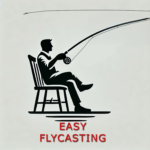
Podcast Episode Title:** “The Crucial Moments: The Art of Catching More Fish”
**Introduction**
* Why do some anglers consistently catch more fish than others? The answer lies in doing things better.
* **Each phase of fly fishing is crucial** to success.
**Episode 1: Preparation and Observation**
* **The Importance of Silence on the River**.
* Fishing out of the water minimizes noise and disturbance of the water surface.
* The trout’s lateral line is a sound-sensitive organ.
* Noise in the water can make the fish more cautious.
* **Making a high backcast** is important to avoid getting caught in bushes.
* One trick is to pull your elbow down and in toward the side to achieve a higher backcast.
**Episode 2: Cast and Loop**
* **Different loops for different situations**.
* A vertical open loop is common, but not ideal for all conditions.
* Controlling the loop parameters: plane, size, trajectory, speed and shape.
* **Avoiding opening the loop too early**.
* Too much force can lead to poor presentation and control.
* **The order of line and leader in the water**.
* Normally the line lands, then the leader, and finally the fly.
* Getting the tip down before the line can give a more natural drift.
* An active leader cast can give better precision and less wind influence.
* One method of presentation is the inductive method, where the loop is opened from below.
**Section 3: When the Fish Strikes**
* A fish rejecting the fly at the last moment is often because it detects an unnatural pull or weight.
* This causes the fish to dodge at the last second.
* The fish becomes more cautious after a strike.
* **Fly selection after a rejection**.
* Instead of changing the pattern, you can try a different size or float level.
* You can also change the angle of presentation, cast type or lengthen your leader.
* **The magic moment** when you feel the line tighten.
* Reel in excess line quickly.
* Switch the rod to the other hand to avoid problems.
* **Handling the fish**.
* Vary the position of the rod to tire the fish faster.
* Also change the direction of the pressure to confuse the fish.
**Section 4: “Fish the Water” with a Dry Fly**
* **Dynamic fishing** with a dry fly.
* Fishing spots and situations that may not initially look interesting can provide surprises.
* This method is good for exploring new pieces of water.
* It is possible to focus on a specific fish if one is seen.
* This type of fishing is compatible with other fishing methods.
* **Tempo and pace**.
* The fishing pace should be fast when there is not much activity in the water.
* The casting pace is different from the fishing pace.
* Many fishermen tend to cast too slowly.
* **Use easy-to-see dry flies**.
* Match the fly to the water you are fishing in.
* **Set the hook slowly but firmly**.
* Pull the line while lifting the rod.
* Remember that a quick pull can result in the fly being ripped out of the fish’s mouth.
**Conclusion**
* Dry fly fishing is full of exciting moments.
* Pay attention to all the little details that can make a big difference.
* **Increase the intensity of the feeling with every fish you catch**.
These show notes contain the main points from the sources and are structured in an easy-to-follow manner. They are designed to be both informative and engaging for the listeners.
